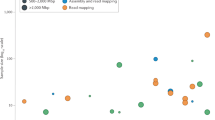Abstract
Next-generation sequencing is limited to short read lengths and by high error rates. We systematically analyzed sources of noise in the Illumina Genome Analyzer that contribute to these high error rates and developed a base caller, Alta-Cyclic, that uses machine learning to compensate for noise factors. Alta-Cyclic substantially improved the number of accurate reads for sequencing runs up to 78 bases and reduced systematic biases, facilitating confident identification of sequence variants.
This is a preview of subscription content, access via your institution
Access options
Subscribe to this journal
Receive 12 print issues and online access
$259.00 per year
only $21.58 per issue
Buy this article
- Purchase on Springer Link
- Instant access to full article PDF
Prices may be subject to local taxes which are calculated during checkout



Similar content being viewed by others
References
Pennisi, E. Science 318, 1842–1843 (2007).
Chi, K.R. Nat. Methods 5, 11–14 (2008).
Korbel, J.O. et al. Science 318, 420–426 (2007).
Hillier, L.W. et al. Nat. Methods 5, 183–188 (2008).
Cokus, S.J. et al. Nature 452, 215–219 (2008).
Whiteford, N. et al. Nucleic Acids Res. 33, e171 (2005).
Chaisson, M. & Pevzner, P. Genome Res. 18, 324–330 (2008).
Metzker, M. Genome Res. 15, 1767–1776 (2005).
Metzker, M., Raghavachari, R., Burgess, K. & Gibbs, R. Biotechniques 25, 814–817 (1998).
Eisen, J.A. et al. PLoS Biol. 4, e286 (2006).
Acknowledgements
We thank M. Rooks, E. Hodges, K. Fejes-Toth and C. Malone for help in preparing libraries. We thank M. Regulski, D. Rebolini and L. Cardone for Illumina sequencing, and T. Heywood for assistance with cluster computing. F. Chen, D. Hillman and J. Eisen (Lawrence Berkeley National Lab) provided the Tetrahymena micronuclear library. Y.E. is a Goldberg-Lindsay Fellow of the Watson School of Biological Sciences. P.P.M. is a Crick-Clay Professor. G.J.H. is an investigator of the Howard Hughes Medical Institute. This work was supported by grants from the US National Institute of Health, the National Science Foundation and the Stanley Foundation.
Author information
Authors and Affiliations
Corresponding author
Supplementary information
Supplementary Text and Figures
Supplementary Figures 1–7, Supplementary Table 1, Supplementary Data, Supplementary Methods (PDF 941 kb)
Rights and permissions
About this article
Cite this article
Erlich, Y., Mitra, P., delaBastide, M. et al. Alta-Cyclic: a self-optimizing base caller for next-generation sequencing. Nat Methods 5, 679–682 (2008). https://doi.org/10.1038/nmeth.1230
Received:
Accepted:
Published:
Issue Date:
DOI: https://doi.org/10.1038/nmeth.1230
This article is cited by
-
Prediction of Effector Proteins from Trichoderma longibrachiatum Through Transcriptome Sequencing
Current Microbiology (2023)
-
What complete mitochondrial genomes tell us about the evolutionary history of the black soldier fly, Hermetia illucens
BMC Ecology and Evolution (2022)
-
The nuclear factor of activated T cells 5 (NFAT5) contributes to the renal corticomedullary differences in gene expression
Scientific Reports (2022)
-
Polyploid giant cancer cells are dependent on cholesterol for progeny formation through amitotic division
Scientific Reports (2022)
-
Transcriptome revealing the dual regulatory mechanism of ethylene on the rhynchophylline and isorhynchophylline in Uncaria rhynchophylla
Journal of Plant Research (2022)



